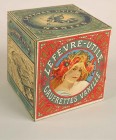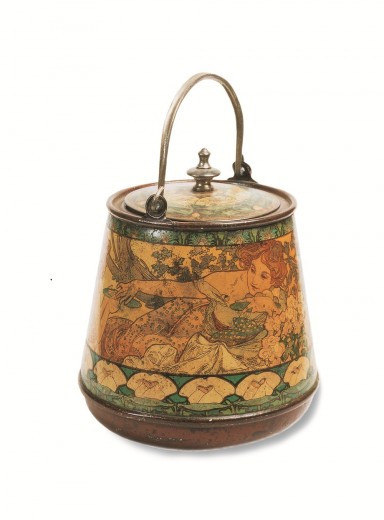
Packaging Design (6 works)
Mucha’s fame as a poster artist led him to commissions for packaging design. In 1896 while he was working on the poster advertising Lance Perfum ‘Rodo’ he was also asked to design the label and the box for the perfume bottle. For the package he used the same image of the woman taken from the poster and thus he created a ‘character’ for the product.
Mucha was also a regular artist for Lefèvre-Utile, the major French biscuit company founded in Nantes in 1846. He designed publicity posters and calendars for them and in 1896 was the first artist to utilise the company’s initials ‘LU’ as a decorative motif with his design for the advertising calendar for 1897. Around 1900 Mucha’s task was expanded to packaging design, which included labels, box tops and the decoration of biscuit tins.
For Mucha, packaging design meant the decoration of objects (products) by applying art to their forms in order to enhance their charm and character. Therefore, as he wrote later, he thought that art should serve as a language to the object to be decorated. This idea is demonstrated in the message carried by the biscuit boxes: the moment of happiness and comfort, as illustrated in the insets, as well as the quality of the products, which is enhanced by the box decorated with the borders emphasising solidity and dignity. Also Mucha produced a ‘brand’ with the use of a consistent font, logo and decorative formula, which linked the packaging with the publicity.
In 1906, while Mucha was working in the United States, he was commissioned to design the wrappers for a set of soaps by the Chicago-based company, Armour & Co. The set featured four floral-scented soaps – violet, lilac, heliotrope and sandalwood – and Mucha designed the packaging in the style he had used for the Parisian decorative panels, featuring beautiful women personifying flowers. The soaps were named ‘Savon Mucha’ after him. By then Mucha had been introduced to the American public as ‘the greatest decorative artist in the world’ (New York Daily News, 1904). With this project, he became the first celebrity artist whose name was used to enhance the popular appeal of commercial products.


